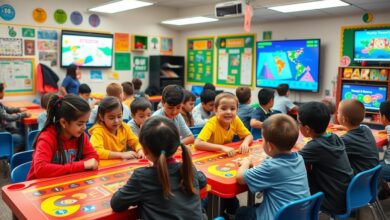Helping Students Read Complex Texts: Strategies for Teachers

Table of Contents
In today’s schools, students face more complex texts than ever. Teachers are key to helping them understand these texts. They use proven methods to teach students how to tackle difficult reading material.
These methods help students better grasp complex ideas. They also improve critical thinking and academic success. Teachers make a big difference in how students learn and develop.
Helping Students Read Complex Texts
A serene classroom filled with diverse students deeply engaged in reading complex books, with multiple pages and colorful diagrams spread across tables, soft sunlight streaming through large windows, and a globe in the corner symbolizing global knowledge.
Understanding the Challenges of Complex Text Comprehension

Reading complex texts can be difficult for many students. They need special text analysis techniques and close reading skills to get the most out of them. It’s important for teachers to know how to help students overcome these challenges.
Common Obstacles Students Face with Difficult Texts
- Unfamiliar vocabulary and specialized terminology
- Difficult sentence structures and writing styles
- Lack of background knowledge or context
- Difficulty finding main ideas, themes, and meanings
- Challenges in making connections and drawing inferences
Impact of Text Complexity on Learning Outcomes
Text complexity can greatly affect student understanding. Struggling with complex texts can lead to:
- Lower interest and motivation to read and learn
- Lower grades on tests and assignments
- Greater difficulty developing critical thinking and problem-solving skills
- Widening achievement gaps between proficient and struggling readers
By using specific teaching methods and focusing on text analysis techniques and close reading skills, students can better handle complex texts. This can lead to greater success in school.
Common Obstacles and Their Impact on Learning Outcomes
| Common Obstacles | Impact on Learning Outcomes |
|---|---|
| Unfamiliar Vocabulary | Decreased engagement and motivation |
| Complex Sentence Structures | Poor performance on assessments |
| Lack of Background Knowledge | Difficulties in critical thinking development |
| Trouble Identifying Main Ideas | Widening achievement gaps |
| Challenges in Synthesizing Information | Difficulty in critical analysis |
“Mastering complex text comprehension is not just an essential academic skill but also a valuable life tool for success.”
Essential Strategies for Complex Text Comprehension
Many students find reading complex texts challenging. However, with the right strategies, you can understand these materials better. Let’s look at some key techniques to help you approach complex readings with confidence.
Activating Prior Knowledge
Before starting a complex text, think about what you already know. Consider how your current knowledge connects to the new information. This helps you make connections and build a strong understanding.
Identifying Key Concepts and Main Ideas
When reading complex texts, focus on the main themes and ideas. Analyze the text’s structure to understand how these elements are presented. This helps you grasp the overall meaning and significance of the passage.
Developing a Strong Vocabulary
Complex texts often use specialized vocabulary. To improve your vocabulary, engage with new words and learn their meanings. This boosts your ability to comprehend text details and communicate your ideas effectively.
Engaging in Close Reading
Close reading means actively working with the text. Slow down, annotate important details, and look for hidden meanings. This method helps you discover deeper insights and understand the material’s complexities.
Making Connections and Drawing Inferences
As you read, link information to your own experiences and knowledge. Use these connections to draw inferences and deepen your understanding. This helps you see the text’s implications and importance.
By mastering these strategies, you’ll be prepared to tackle complex materials. Practice regularly and engage deeply with the text. These steps will help you succeed.
Implementing Close Reading Skills in the Classroom
Teachers play a key role in helping students understand difficult texts. A great way is to teach close reading skills. Close reading means carefully analyzing a text to find deep meanings and understand it better.
Pre-Reading Activities and Text Previewing Techniques
Start by preparing students for reading with pre-reading activities. Have them look at the title, headings, and pictures before they start. This helps them use what they already know and makes them more excited to read.
Annotation Methods for Better Comprehension
While reading, teach students to use annotation techniques. Encourage them to highlight important parts, write notes in the margins, and look up words they don’t know. This hands-on method helps them develop close reading skills and text analysis techniques.
Post-Reading Analysis and Discussion
After reading, lead a discussion about the text. Ask students what they noticed, thought about, and wondered. This helps them dig deeper into the content and improve their critical thinking.
Using these close reading strategies in your classroom can help students feel more confident when they face challenging texts.
Close Reading Skills
A serene classroom featuring various open books scattered across tables, with highlighted complex text passages, magnifying glasses, and colorful sticky notes. Sunlight streams through the windows, creating soft shadows, while in the background, a whiteboard displays a diagram illustrating close reading techniques. A cozy reading nook is visible in one corner, with comfortable cushions and a small shelf filled with diverse literature.
Building Strong Vocabulary Development Programs
Building a strong vocabulary is key for students to read and understand complex texts. Teachers can use many strategies to help with this. These methods fit different learning styles and student needs.
Contextual Learning
Contextual learning is a great way to teach new words. Students learn by seeing words in sentences or passages. This method keeps students engaged and helps them remember words better.
Word-Building Exercises
Word-building exercises are also helpful. By learning word roots, prefixes, and suffixes, students expand their vocabulary. This not only improves their reading but also boosts their language understanding.
Using Academic Language in the Classroom
Another good strategy is to use academic language in the classroom. This strategy makes students comfortable with complex texts. Learning the language of academics helps them succeed in reading.
“Effective vocabulary instruction is not just about memorizing words; it’s about building a deep understanding of language that empowers students to tackle complex texts with confidence.”
With a strong vocabulary program, teachers can help students overcome reading challenges. This opens the door to academic success.
Helping Students Read Complex Texts Through Scaffolding

Reading complex texts can be tough for many students. But, with the right scaffolding, teachers can help them. The “gradual release of responsibility” model is a great way to do this. This model shifts from teacher-led learning to student-focused learning.
Gradual Release of Responsibility Model
This model helps students learn to read complex texts step by step. It starts with the teacher showing how to do it. Then, as students get better, they take on more responsibility. This lets them practice on their own.
Supporting Struggling Readers
Students who find complex texts hard need extra help. Teachers can use differentiated instruction to support them. This might involve extra resources like graphic organizers or text-to-speech tools.
Advanced Tools for Text Navigation
- Interactive annotations and highlighting
- Customizable text formatting options
- Built-in dictionaries and thesauruses
- Collaborative annotation and discussion features
By using advanced tools, teachers can help students interact with complex texts. This helps boost critical thinking and develop important skills.
A good way to scaffold complex texts and differentiated instruction prepares students for success in their studies.
Using Critical Thinking in Reading
Critical thinking is an essential skill for reading and understanding complex texts. It helps students analyze texts more deeply, extract meaning, and evaluate information. By encouraging critical thinking, teachers can help students better comprehend complex texts.
Critical Analysis of Perspective
Students should learn how to identify the perspective from which a text is written. Is it objective or does it contain bias? Analyzing perspective helps students assess the text’s credibility and the messages it conveys.
Reflecting on Word Connotations
Words carry multiple meanings. By critically reflecting on word connotations, students can grasp different dimensions of meaning. This includes examining the context in which words appear.
Questioning Assumptions
Encouraging students to question assumptions in the text helps them consider the evidence the writer supports. This develops critical and analytical skills, helping students approach complex texts with greater confidence.
“Critical thinking opens doors to deep understanding, helping students interact with texts in a smart and calculated way.”
Practicing Reading Skills in a Social Context
Learning can be more effective when it takes place in a social context. Group activities encourage students to discuss and analyze texts with others. This enhances their understanding and prompts them to articulate their opinions better.
Group Discussions and Constructive Criticism
Discussing texts in groups can be beneficial. It encourages students to offer their perspectives and analyze others’ texts. These activities foster critical thinking and help students understand texts more deeply.
Using Technology in Social Learning
Technology can significantly contribute to fostering collaborative learning. By using interactive platforms or forums, students can share ideas, discussions, and text analyses with their classmates.
Motivating Collaboration and Participation
By motivating collaboration among students, teachers can further enhance reading skills. When students collaborate on text analysis, they develop critical thinking and deep comprehension skills.
Group discussions and the use of technology are powerful tools for fostering student collaboration and enhancing their understanding of complex texts.
Self-Assessments and Analysis
It’s important for students to learn how to assess their own reading. Self-assessments help them understand their progress and identify areas where they need to improve. By using self-assessments, students can continuously develop their reading skills.
Reflecting on Individual Challenges
Encourage students to reflect on the challenges they face while reading. Were there difficult words or concepts? Did the text have complex structures? Through these analyses, students can identify areas for improvement.
Using Reading Logs
Reading logs can be an effective tool to help students assess their reading. By writing notes about the texts they’ve read, they can track their progress and better analyze their comprehension.
Reviewing Old Texts and Reflecting on Improvements
Reviewing old texts and looking for areas that can be improved helps students develop their reading skills. Through regular review, students can increase their proficiency in analyzing complex texts.
Self-assessment helps develop critical thinking skills and encourages students to continuously improve their academic performance.
Differentiated Instruction and Student Engagement
Teaching should be flexible to meet the diverse needs of students. Differentiated instruction means adapting teaching methods to fit each student’s needs. This allows students to get the right support, helping them better understand complex texts.
Adapting Complex Texts for Different Students
Changing complex texts is a big part of teaching. This might mean using simpler words, breaking texts into smaller parts, or adding extra help like glossaries. Teachers can also give different texts for students to choose from based on their reading level.
Individual and Group Reading Methods
Adaptive teaching techniques help boost students’ ability to handle complex texts. This includes using educational technology like tools that offer extra explanations or corrected texts.
Focusing on Individual Strengths
Teachers can help students build on their individual strengths. By tailoring activities that enhance strengths, students can interact with texts more effectively.
Differentiated instruction is an important tool in helping students develop reading and comprehension skills. By adapting teaching methods, teachers can provide the support each student needs.
Using Stories in Teaching Complex Texts

Stories are a powerful tool in teaching complex texts. By presenting texts in a narrative context, students can better understand concepts. Stories help students connect concepts to everyday life events, which enhances comprehension.
Introducing Complex Narrative Texts
When teaching complex texts, stories can be used as a means to facilitate understanding. Stories offer visual and emotional elements that help students remember and retain key details.
Teaching Literature Through Stories
Literature is an ideal field for applying this strategy. By presenting complex literary stories, students can analyze vocabulary, style, and characters in an enjoyable and interesting way.
Using stories is a powerful teaching tool to facilitate learning and motivate students to explore complex texts more deeply.
“Stories make complex texts more understandable and help students connect concepts to life experiences, which fosters deep comprehension.”
Integrating Critical Thinking and Metacognitive Strategies
Students encounter challenging texts every day. It’s important to equip them with the tools for critical thinking and metacognitive strategies. These tools help students understand and remember what they read better.
Critical thinking allows students to ask deep questions and find answers. It helps them see things clearly. Metacognitive strategies, meanwhile, help students keep track of their learning and figure out what they don’t know.
Using both tools together can really help students make sense of complex texts. When they question, think deeply, and check their work, they learn more. They can also use what they learn in new ways.
Teachers can use several methods to help students:
- Show how to break down texts and pull out main points.
- Encourage students to ask questions and think critically.
- Let students annotate texts and share their thoughts.
- Set up group discussions for students to share their viewpoints.
By teaching critical thinking and metacognitive skills, educators can transform how students approach difficult texts. Students will engage more deeply and learn more.
Critical Thinking
An innovatively designed brain composed of intricate gears and circular patterns, surrounded by open books and swirling pages, illustrating the integration of logic and creativity, against a vibrant background representing knowledge and exploration.
| Skill | Description | Benefits |
|---|---|---|
| Critical Thinking | The ability to analyze, evaluate, and draw conclusions from information. | Enhances comprehension, problem-solving, and decision-making. |
| Metacognitive Strategies | Techniques involving self-awareness, self-monitoring, and self-regulation of the learning process. | Improves self-directed learning, adaptability, and transfer of knowledge to new situations. |
“Teaching students to think critically and to reflect on their own learning is essential for their success in navigating complex texts and achieving academic excellence.”
Differentiating Instruction for Different Reading Levels
Teachers know that students have varied reading skills. It’s important to adjust learning to fit each student’s needs. This way, everyone can understand and enjoy complex texts.
Adapting Complex Texts for Different Students
Changing complex texts is a big part of teaching. This might mean using simpler words, breaking texts into smaller parts, or adding extra help like glossaries. Teachers can also give different texts for students to choose from based on their reading level.



